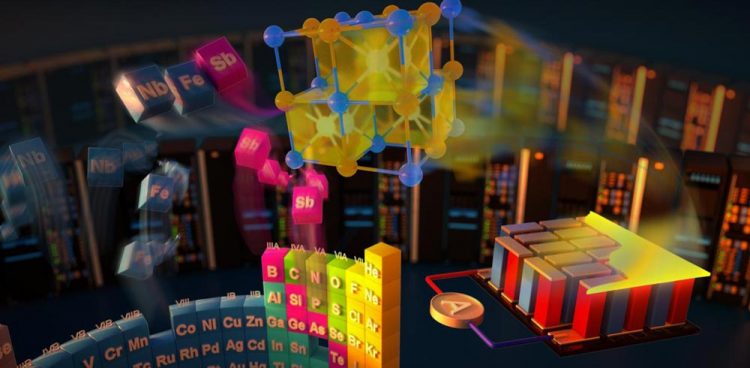Speeding up material discovery

A new algorithm uses the chemical elements in a crystal to predict its material properties. The algorithm simplifies computational required for material discovery and speeds up the process by about 10,000 times, compared to existing algorithms. Image courtesy of Second Bay Studios/Harvard SEAS
In even the most fuel-efficient cars, about 60 percent of the total energy of gasoline is lost through heat in the exhaust pipe and radiator. To combat this, researchers are developing new thermoelectic materials that can convert heat into electricity. These semiconducting materials could recirculate electricity back into the vehicle and improve fuel efficiency by up to 5 percent.
The challenge is, current thermoelectric materials for waste heat recovery are very expensive and time consuming to develop. One of the state of the art materials, made from a combination of hafnium and zirconium (elements most commonly used in nuclear reactors), took 15 years from its initial discovery to optimized performance.
Now, researchers from the Harvard John A. Paulson School of Engineering and Applied Sciences (SEAS) have developed an algorithm that can discover and optimize these materials in a matter of months, relying on solving quantum mechanical equations, without any experimental input.
“These thermoelectric systems are very complicated,” said Boris Kozinsky, a recently appointed Associate Professor of Computational Materials Science at SEAS and senior author of the paper. “Semiconducting materials need to have very specific properties to work in this system, including high electrical conductivity, high thermopower, and low thermal conductivity, so that all that heat gets converted into electricity. Our goal was to find a new material that satisfies all the important properties for thermoelectric conversion while at the same time being stable and cheap.”
Kozinsky co-authored the research with Georgy Samsonidze, a research engineer at the Robert Bosch Research and Technology Center in Cambridge, MA, where both authors conducted most of the research.
In order to find such a material, the team developed an algorithm that can predict electronic transport properties of a material based only on the chemical elements used in the crystalline crystal. The key was to simplify the computational approach for electron-phonon scattering and to speed it up by about 10,000 times, compared to existing algorithms.
The new method and computational screening results are published in Advanced Energy Materials.
Using the improved algorithm, the researchers screened many possible crystal structures, including structures that had never been synthesized before. From those, Kozinsky and Samsonidze whittled the list down to several interesting candidates. Of those candidates, the researchers did further computational optimization and sent the top performers to the experimental team.
In an earlier effort experimentalists synthesized the top candidates suggested by these computations and found a material that was as efficient and as stable as previous thermoelectric materials but 10 times cheaper. The total time from initial screening to working devices: 15 months.
“We did in 15 months of computation and experimentation what took 15 years for previous materials to be optimized,” said Kozinsky. “What's really exciting is that we're probably not fully understanding the extent of the simplification yet. We could potentially make this method even faster and cheaper.”
Kozinsky said he hopes to improve the new methodology and use it to explore electronic transport in a wider class of new exotic materials such as topological insulators.
###
This work was supported by the U.S. Department of Energy and Robert Bosch LLC.
Media Contact
More Information:
https://www.seas.harvard.edu/news/2018/04/speeding-up-material-discoveryAll latest news from the category: Materials Sciences
Materials management deals with the research, development, manufacturing and processing of raw and industrial materials. Key aspects here are biological and medical issues, which play an increasingly important role in this field.
innovations-report offers in-depth articles related to the development and application of materials and the structure and properties of new materials.
Newest articles

A ‘language’ for ML models to predict nanopore properties
A large number of 2D materials like graphene can have nanopores – small holes formed by missing atoms through which foreign substances can pass. The properties of these nanopores dictate many…

Clinically validated, wearable ultrasound patch
… for continuous blood pressure monitoring. A team of researchers at the University of California San Diego has developed a new and improved wearable ultrasound patch for continuous and noninvasive…

A new puzzle piece for string theory research
Dr. Ksenia Fedosova from the Cluster of Excellence Mathematics Münster, along with an international research team, has proven a conjecture in string theory that physicists had proposed regarding certain equations….



